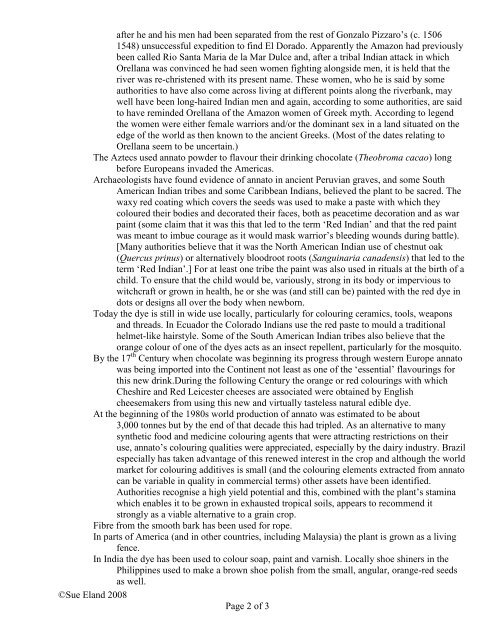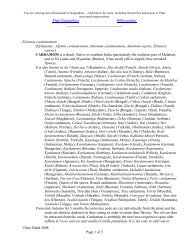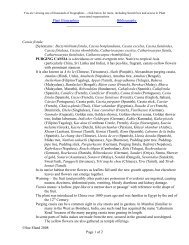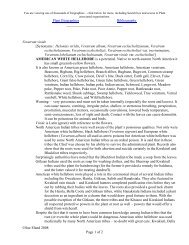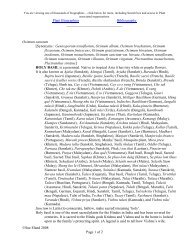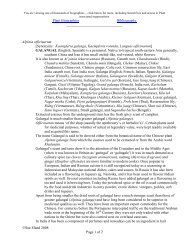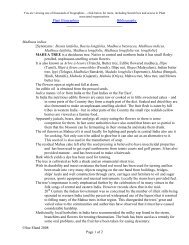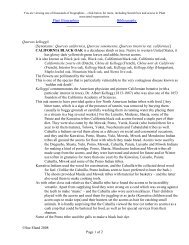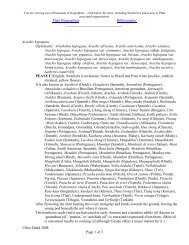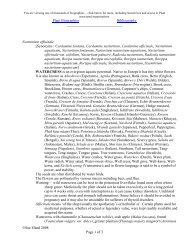Annato - Plant Biographies
Annato - Plant Biographies
Annato - Plant Biographies
Create successful ePaper yourself
Turn your PDF publications into a flip-book with our unique Google optimized e-Paper software.
after he and his men had been separated from the rest of Gonzalo Pizzaro’s (c. 1506<br />
1548) unsuccessful expedition to find El Dorado. Apparently the Amazon had previously<br />
been called Rio Santa Maria de la Mar Dulce and, after a tribal Indian attack in which<br />
Orellana was convinced he had seen women fighting alongside men, it is held that the<br />
river was re-christened with its present name. These women, who he is said by some<br />
authorities to have also come across living at different points along the riverbank, may<br />
well have been long-haired Indian men and again, according to some authorities, are said<br />
to have reminded Orellana of the Amazon women of Greek myth. According to legend<br />
the women were either female warriors and/or the dominant sex in a land situated on the<br />
edge of the world as then known to the ancient Greeks. (Most of the dates relating to<br />
Orellana seem to be uncertain.)<br />
The Aztecs used annato powder to flavour their drinking chocolate (Theobroma cacao) long<br />
before Europeans invaded the Americas.<br />
Archaeologists have found evidence of annato in ancient Peruvian graves, and some South<br />
American Indian tribes and some Caribbean Indians, believed the plant to be sacred. The<br />
waxy red coating which covers the seeds was used to make a paste with which they<br />
coloured their bodies and decorated their faces, both as peacetime decoration and as war<br />
paint (some claim that it was this that led to the term ‘Red Indian’ and that the red paint<br />
was meant to imbue courage as it would mask warrior’s bleeding wounds during battle).<br />
[Many authorities believe that it was the North American Indian use of chestnut oak<br />
(Quercus prinus) or alternatively bloodroot roots (Sanguinaria canadensis) that led to the<br />
term ‘Red Indian’.] For at least one tribe the paint was also used in rituals at the birth of a<br />
child. To ensure that the child would be, variously, strong in its body or impervious to<br />
witchcraft or grown in health, he or she was (and still can be) painted with the red dye in<br />
dots or designs all over the body when newborn.<br />
Today the dye is still in wide use locally, particularly for colouring ceramics, tools, weapons<br />
and threads. In Ecuador the Colorado Indians use the red paste to mould a traditional<br />
helmet-like hairstyle. Some of the South American Indian tribes also believe that the<br />
orange colour of one of the dyes acts as an insect repellent, particularly for the mosquito.<br />
By the 17 th Century when chocolate was beginning its progress through western Europe annato<br />
was being imported into the Continent not least as one of the ‘essential’ flavourings for<br />
this new drink.During the following Century the orange or red colourings with which<br />
Cheshire and Red Leicester cheeses are associated were obtained by English<br />
cheesemakers from using this new and virtually tasteless natural edible dye.<br />
At the beginning of the 1980s world production of annato was estimated to be about<br />
3,000 tonnes but by the end of that decade this had tripled. As an alternative to many<br />
synthetic food and medicine colouring agents that were attracting restrictions on their<br />
use, annato’s colouring qualities were appreciated, especially by the dairy industry. Brazil<br />
especially has taken advantage of this renewed interest in the crop and although the world<br />
market for colouring additives is small (and the colouring elements extracted from annato<br />
can be variable in quality in commercial terms) other assets have been identified.<br />
Authorities recognise a high yield potential and this, combined with the plant’s stamina<br />
which enables it to be grown in exhausted tropical soils, appears to recommend it<br />
strongly as a viable alternative to a grain crop.<br />
Fibre from the smooth bark has been used for rope.<br />
In parts of America (and in other countries, including Malaysia) the plant is grown as a living<br />
fence.<br />
In India the dye has been used to colour soap, paint and varnish. Locally shoe shiners in the<br />
Philippines used to make a brown shoe polish from the small, angular, orange-red seeds<br />
as well.<br />
©Sue Eland 2008<br />
Page 2 of 3


